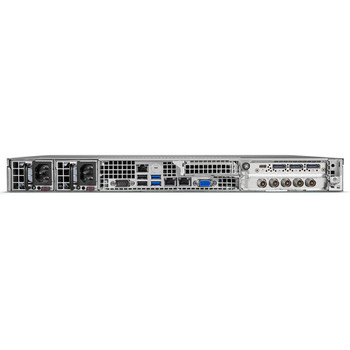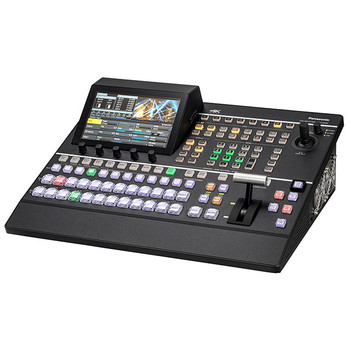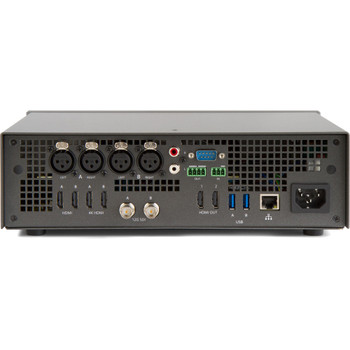AJA BLVE-12G-4 BRIDGE LIVE 4xHD or 4K Video Encoding, Decoding, Streaming, and Transcoding Appliance for Live Video
Turnkey UHD 4K 12G-SDI I/O Solution
Add the BRIDGE LIVE 12G-4 Turnkey System with 1 RU Appliance + 4 Bidirectional 12G-SDI I/O from AJA to your streaming content network for high-density, low-latency video streaming up to UHD 4K60. This turnkey, 1 RU solution features BRIDGE LIVE UHD software to encode/decode SDI video content to IP streams and IP to SDI in real time.
BRIDGE LIVE Product Family
The BRIDGE LIVE 12G-4 supports the most widely used IP video compression schemes and transport protocols to solve your workflow needs. The BRIDGE LIVE family supports conversion to/from SDI to numerous IP video solutions as well as pure IP conversion and distribution workflows.
For example, with a pair of BRIDGE LIVE systems, a broadcast facility can receive three incoming encoded camera sources from a remote location and decode them back into SDI for editing and production while simultaneously providing program return to the remote location. BRIDGE LIVE 12G-4 supports up to four UHD 4K60 channels.
NDI Support
BRIDGE LIVE 12G-4 includes support for NDI (Network Device Interface), the high-quality, real-time, low-latency IP video standard developed by NewTek. BRIDGE LIVE can support up to four simultaneous UHD 4K60 NDI encodes/decodes to/from SDI. BRIDGE LIVE's NDI functionality offers:
- SDI to NDI (encode)
- NDI to SDI (decode)
- IP video streams to NDI (transcode)
- NDI to IP video streams (transcode)
- Multiple discovery servers
Synchronous Multichannel Transport
BRIDGE LIVE and BRIDGE LIVE 12G-4 support independent SDI source inputs and maintain their synchronous relationship while transporting the content to end-point destinations. This functionality can take place between a pair of BRIDGE LIVE units for a synchronous end-to-end SDI workflow, often referred to as SDI backhaul, or site-to-site SDI workflows.
SRT Ready
BRIDGE LIVE 12G-4 supports SRT v1.5.3, enabling redundant stream support over an ISP to ensure hitless delivery of the originating source. SRT is an open-source video transport protocol and technology stack that optimizes streaming performance across unpredictable networks with secure streams and easy firewall traversal, bringing the best-quality live video over questionable networks.
Metadata, HDR, Timecode, and Closed Captioning Support
BRIDGE LIVE 12G-4 fully supports closed captioning as well as additional metadata, including:
- UHD 4K single link, SMPTE ST 2082, 10-bit
- MPEG-2 ancillary packet support (SMPTE ST 2038)
- SDR/HDR Transfer Characteristics, Colorimetry, Luminance via SDI
- SCTE-35/SCTE-104 Ad insertion markers
- CEA-608/CEA-708 closed captioning
- Line 21 Captions
- Timecode embedded within H.264 SEI messages
- Embedding closed captioning/subtitles into H.264 SEI messages
- Metadata passthrough
- Electronic Program Guide (EPG) on input
Containers and Protocol Support
BRIDGE LIVE 12G-4 can be configured using multiple protocols to meet your workflow requirements, whether it's low-latency or high-quality signal delivery. Supported protocols include HLS (input and output), MPEG-TS, MPTS (input), RTMP, RTMPS (output), RTP, UDP, SRT (including encryption), VSF TR-01, and VSF TR-07.
Encoding/Decoding
BRIDGE LIVE 12G-4 supports numerous configurations for encoding and decoding between SDI and streaming formats as standard. Multiple streams, formats, and destinations can be derived from a single SDI input. It supports various configurations using NDI, H.265 (HEVC), H.264 (AVC), and H.262 (MPEG-2). Optional JPEG XS (TR 07) and JPEG 2000 (TR-01) encode/decode licenses can be purchased separately.
Video Preview
A video preview feature provides a visual check, so that operators can ensure they have the correct SDI input/content for encoding. It promotes basic confidence while providing customers who cannot "go live" to check their content with added peace of mind.
Hardware
The BRIDGE LIVE 12G-4 supports up to four 12G-SDI ports simultaneously for multichannel HD in a 1 RU chassis. Dual 10 GigE ports provide network connectivity, and it has dual power supplies for redundancy.









